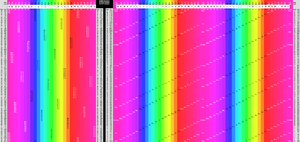81edo: Difference between revisions
misc cleanup |
→Notation: elaborate, fix image size |
||
| Line 7: | Line 7: | ||
]] | ]] | ||
81edo is notable as a tuning for [[meantone family|meantone]] and related temperaments and is the [[optimal patent val]] for a number of them. In particular it is the optimal patent val for 5-limit meantone, 7-limit meantone, 11-limit meanpop, 13-limit meanpop, and the rank three temperament [[Didymus rank three family|erato]]. The electronic music pioneer [https://web.archive.org/web/20120211182601/http://daphneoram.org/2012/01/13/letter-from-yehudi-menuhin/ Daphne Oram] was interested in 81edo. | 81edo is notable as a tuning for [[meantone family|meantone]] and related temperaments and is the [[optimal patent val]] for a number of them. In particular it is the optimal patent val for 5-limit meantone, 7-limit meantone, 11-limit meanpop, 13-limit meanpop, and the rank three temperament [[Didymus rank three family|erato]]. The electronic music pioneer [https://web.archive.org/web/20120211182601/http://daphneoram.org/2012/01/13/letter-from-yehudi-menuhin/ Daphne Oram] was interested in 81edo. As a step in the [[Golden meantone]] series of EDOs, 81 EDO marks the point at which the series ceases to display audible changes to meantone temperament, and is also the EDO with the lowest average and most evenly spread Just-error across the scale (though 31 EDO does have the best harmonic 7th). | ||
Besides meantone, 81edo is a tuning for the [[cobalt]] temperament, since it contains 27 as a divisor. It also tunes the unnamed 15 & 51 temperament which divides the octave into 3 equal parts, and is a member of the [[augmented-cloudy equivalence continuum]]. 81bd val is a tuning for the [[Porcupine family#Septimal porcupine|septimal porcupine]] temperament. | |||
In the higher limits, it is a strong tuning for the 2.5.17.19 subgroup, and also can be used to map 19/17 to the meantone major second resulting from stacking of two panent val fifths (13\81). | |||
=== Odd harmonics === | === Odd harmonics === | ||
{{harmonics in equal|81}} | {{harmonics in equal|81}} | ||
=== Subsets and supersets === | |||
Since 81 is equal to 3<sup>4</sup>, a perfect power of 3, 81edo contains subset edos {{EDOs|1, 3, 9, 27}}. | |||
== Notation == | == Notation == | ||
81 EDO Accidentals created and used by Tom Winspear, based on those provided in Scala though with a logic correction. The innermost accidentals represent one EDOstep, followed by two, then the bracket representing three. Conventional sharp/doublesharp/flat/doubleflat accidentals are reached in steps of five and the pattern repeats itself on them. | === Tom Winspear's notation === | ||
The chromatic scale can be notated utilizing only six accidentals in either direction - the rest are for enharmonics. | [[File:81 EDO Accidentals.png|alt=|959x959px]] | ||
81 EDO Accidentals created and used by Tom Winspear, based on those provided in Scala though with a logic correction. The innermost accidentals represent one EDOstep, followed by two, then the bracket representing three. Conventional sharp/doublesharp/flat/doubleflat accidentals are reached in steps of five and the pattern repeats itself on them. The chromatic scale can be notated utilizing only six accidentals in either direction - the rest are for enharmonics. | |||
== Regular temperament properties == | == Regular temperament properties == | ||
=== Commas === | === Commas === | ||
Revision as of 14:39, 30 June 2023
| ← 80edo | 81edo | 82edo → |
Theory

81edo is notable as a tuning for meantone and related temperaments and is the optimal patent val for a number of them. In particular it is the optimal patent val for 5-limit meantone, 7-limit meantone, 11-limit meanpop, 13-limit meanpop, and the rank three temperament erato. The electronic music pioneer Daphne Oram was interested in 81edo. As a step in the Golden meantone series of EDOs, 81 EDO marks the point at which the series ceases to display audible changes to meantone temperament, and is also the EDO with the lowest average and most evenly spread Just-error across the scale (though 31 EDO does have the best harmonic 7th).
Besides meantone, 81edo is a tuning for the cobalt temperament, since it contains 27 as a divisor. It also tunes the unnamed 15 & 51 temperament which divides the octave into 3 equal parts, and is a member of the augmented-cloudy equivalence continuum. 81bd val is a tuning for the septimal porcupine temperament.
In the higher limits, it is a strong tuning for the 2.5.17.19 subgroup, and also can be used to map 19/17 to the meantone major second resulting from stacking of two panent val fifths (13\81).
Odd harmonics
| Harmonic | 3 | 5 | 7 | 9 | 11 | 13 | 15 | 17 | 19 | 21 | 23 | |
|---|---|---|---|---|---|---|---|---|---|---|---|---|
| Error | Absolute (¢) | -5.66 | -1.13 | -5.86 | +3.50 | -3.17 | +3.92 | -6.79 | -1.25 | -1.22 | +3.29 | -6.05 |
| Relative (%) | -38.2 | -7.6 | -39.6 | +23.6 | -21.4 | +26.4 | -45.8 | -8.4 | -8.2 | +22.2 | -40.9 | |
| Steps (reduced) |
128 (47) |
188 (26) |
227 (65) |
257 (14) |
280 (37) |
300 (57) |
316 (73) |
331 (7) |
344 (20) |
356 (32) |
366 (42) | |
Subsets and supersets
Since 81 is equal to 34, a perfect power of 3, 81edo contains subset edos 1, 3, 9, 27.
Notation
Tom Winspear's notation
81 EDO Accidentals created and used by Tom Winspear, based on those provided in Scala though with a logic correction. The innermost accidentals represent one EDOstep, followed by two, then the bracket representing three. Conventional sharp/doublesharp/flat/doubleflat accidentals are reached in steps of five and the pattern repeats itself on them. The chromatic scale can be notated utilizing only six accidentals in either direction - the rest are for enharmonics.
Regular temperament properties
Commas
- 5-limit commas: 81/80, [-48 1 20⟩
- 7-limit commas: 81/80, 126/125, [-24 1 0 8⟩
- 11-limit commas: 81/80, 126/125, 385/384, 12005/11979
- 13-limit commas: 81/80, 105/104, 144/143, 196/195, 6655/6591